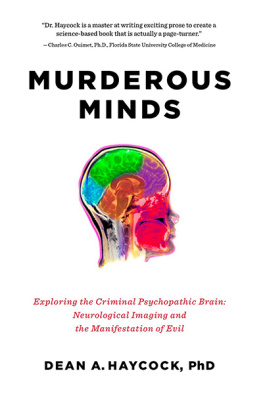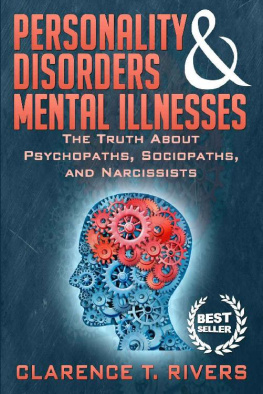
Murderous Minds
Exploring the Criminal Psychopathic Brain: Neurological Imaging and the Manifestation of Evil
Dean A. Haycock, Ph.D.

For Marie E. Culver
Contents
Preface
T HE NEUROSCIENTISTS AND PSYCHOLOGISTS who are leading the way in the study of psychopathic personalities describe their fascinating research subjects by referring to the traits that distinguish them from 99 percent of the population. Some of these traits are related to emotional deficits such as lack of deep emotional attachments to other people and lack of empathy and guilt. Some traits like narcissism and superficial charm are related to how psychopaths interact with others. Their dishonesty, manipulativeness, recklessness and risk-taking activities are representative of their impulsive and antisocial behaviors.
The members of the Society for the Scientific Study of Psychopathy caution that Although psychopathy is a risk factor for physical aggression, it is by no means synonymous with it. In contrast to individuals with psychotic disorders, most psychopaths are in touch with reality and seemingly rational. Psychopathic individuals are found at elevated rates in prisons and jails, but can be found in community settings as well. The Society makes it clear that psychopathy is not the same thing as violence, serial killing, psychosis, mental illness, or what the American Psychiatric Association calls antisocial personality disorder.
Murderous Minds is about a subgroup of psychopaths called criminal psychopaths. They share traits with non-criminal psychopaths, but they should not be equated with them. Criminal psychopathy refers instead to a meaner, more aggressively disinhibited conception of psychopathy that explicitly entails persistent and sometimes serious criminal behavior, psychologist Jennifer Skeem, Ph.D., and her co-authors declared in 2011.
Criminal psychopaths are the only subgroup of psychopath for which there exists enough reproducible neurobiological data to begin to get a preliminary idea of how their brain structure and function relates to their antisocial behavior. This is in large part because many criminal psychopaths are currently in prison and thus researchers have had better access to this captive subgroup of the psychopathic population compared to non-criminal psychopaths, who are not incarcerated and therefore free citizens. Spread out geographically, many in this subgroup are more difficult to identify, test, and recruit or have no interest or desire to submit their brains to study. But when the brains of functional or successful psychopaths have been studied as extensively as the brains of their criminal counterparts, they, too, will deserve a book devoted to them.
Foreword
T HE WORLD OF THE CRIMINAL psychopath is at once creepy and fascinating. You read about criminal psychopaths in the news, you see them portrayed in movies, you read about them in books. They do terrible things, horrific things. They are capable of murder, robbery, torture, and rape and they can do it all without a hint of remorse or a touch of empathy. And you wonder: how can these people be so evil?
You hope you do not run across them, but could you recognize a psychopath if you met one? Given that an estimated 1 out of 100 adults is a psychopath, the chances are in fact quite good that you have met some of them without realizing who or what they were. You may even have married one (psychopaths can be incredibly charming when they want or need to be). Have you joked at work that your boss is a psychopath? That could actually be the casemany non-criminal psychopaths are not violent. They can control their antisocial impulses and even attain mixed success as business executives. They do not fret over making difficult decisions that have a severe negative impact on their employees. They simply do what is best for themselves.
Does someone become a psychopath, or is one born a psychopath? Can psychopathy be treated or cured? Are the brains of psychopaths physically different from normal brains? If so, can society hold psychopaths to be morally responsible for what they have done? Can modern neuroscience identify psychopathic brains early on, before a psychopath has a chance to commit a crime? If so, should those thus identified be incarcerated before they have a chance to do something terrible?
Neuroscientists can, in fact, use brain-imaging techniques to identify physical differences in the brains of psychopaths vs. normal people. Further, structural abnormalities seen in specific brain regions in psychopaths are thought to underlie the striking emotional abnormalities that can be measured by psychological testing.
At first glance, the taskof understanding how abnormalities in specific brain areas arise, and how these abnormalities account for psychopathic behavioris daunting. In this book, however, Dr. Dean Haycock has taken extremely complex material and rendered it readily digestible. One does not have to be a psychologist or a neuroscientist to understand this book. At the same time, the science has not been made more simple than necessary, and the topics covered have such breadth and depth that the book is also appropriate for professionals in the field. The information presented is evidence-based, and one cannot find a single example of information that is simply hearsay or otherwise unsubstantiated; the book is thoroughly documented with complete reference lists for each chapter. Moreover, Dr. Haycock has taken the extra steps of interviewing several of the major players in the field and accurately presenting their viewpoints. Finally, Dr. Haycock is a master at writing exciting prose to create a science-based book that is actually a page-turner. From psychopathic Eskimos to mass-murdering high school students, the true nature of the criminal psychopath is explored here. And that exploration is such that it leads us not only to a better understanding of the criminal psychopath, but to a better understanding of ourselves.
Charles C. Ouimet, Ph.D.,
Professor and Faculty Scholar in Neuroscience,
Florida State University College of Medicine,
Tallahassee, Florida
Introduction
H AVING A MURDEROUS MIND is not always the same thing as being a murderer or even having the intention of killing. A glance into the Merriam-Webster dictionary confirms it. The primary definition of murderous is indeed having the purpose or capability of murder and characterized by or causing murder or bloodshed. This accurately describes the psychopaths who fill the pages of true-crime books and are featured in news or infotainment stories. Criminals who lack a conscience, the sadistic psychopathic serial killers like Ted Bundy and John Wayne Gacy, the unfeeling psychopaths like Richard Kuklinsky who kill for personal gain, the school shooter Eric Harris, the rapist and murderer Brian Dugan, and the armed robber who kills without remorse to keep from being captured and then blames the victim, all have the purpose of murder.
The secondary and, in this context, more relevant definition of murderous is having the ability or power to overwhelm: devastating. Without a conscience, and with a strong impulse to dominate and victimize, criminal psychopaths and some psychopaths who have avoided encounters with the law routinely leave their victims feeling overwhelmed and devastated. Consider the following synonyms of murderous. After marrying or being conned by a psychopath, many victims have gained firsthand experience with most of them: brutal, cruel, hard, harsh, oppressive, rough, searing, and, most intriguingly, inhuman. These offenses may involve more psychological than physical abuse, but by the dictionary definition they are murderous
Next page










